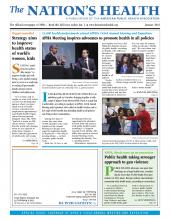Energy drinks popular among teens
Teens are regular consumers of energy drinks, with some groups drinking more than others, according to research presented at APHA’s 143rd Annual Meeting and Exposition in November.
Based on data from the Monitoring the Future survey of eighth-, 10th- and 12th-graders between 2010 and 2013, researchers found that eighth-graders reported the highest percentage of energy drink consumption, followed by those in 12th grade and those in 10th grade. Energy drinks typically contain stimulants such as caffeine, taurine, guarana as well as sugar or sweeteners.
Among the tens of thousands of young people who participated in the survey, prevalence of energy drink consumption was higher among boys than girls in all grades and years. Also, black students reported the lowest percentage of energy drink consumption, while Hispanic students reported the highest.
Overall, energy drink consumption decreased in the 10th and 12th grades from 2010 to 2013, while such consumption remained mostly stable among eighth-graders during the study period. Among black students, energy drink consumption declined in eighth grade and 10th grade. (Abstract 332310)
Increased disaster awareness leads to higher preparedness level
Higher awareness equals more preparedness, according to a study presented at the Annual Meeting.
Researchers from the Centers for Disease Control and Prevention studied the impact of disaster awareness on emergency preparedness using data from Ready CDC, a pilot designed to engage CDC’s workforce in preparedness. Awareness was defined as “high” if the study participant was aware of a variety of preparedness needs and information, such as the need for an emergency kit and a written plan as well as what kind of disaster is likely to occur in her or his county. Among those surveyed, preparedness behaviors differed significantly between those with low and high awareness.
For example, 21 percent of those with low awareness had an emergency kit, while 51 percent with high awareness did. Also, 7 percent with low awareness had an emergency plan, versus 13 percent of those with high awareness. Only 40 percent of low-awareness participants received emergency alerts, versus 60 percent of those with high awareness. (Abstract 331307)
Opt-out HIV testing in correctional facilities detects new infections
Offering HIV testing on an opt-out basis in a correctional facility significantly increased the number of people screened for the disease, according to research presented at the Annual Meeting.
While many jails conduct opt-in HIV testing, Chicago’s Cook County Jail instituted opt-out HIV testing in 2011 as a routine part of its intake process. Opt-out testing means all detainees are tested unless they formally decline or are already diagnosed with HIV. At Cook County Jail, which initially began the opt-out testing with women, detainees gave written consent for all health services with an option to refuse HIV and sexually transmitted disease screenings.
According to the study, before HIV opt-out testing began, 15 percent to 30 percent of women were tested annually during a post-intake, opt-in procedure. After adopting an opt-out protocol, the total proportion of women tested increased to 51 percent in 2012 and 42 percent in 2013. In addition, the opt-out protocol revealed an HIV prevalence of 1.26 percent between 2012 and 2014, with 18 percent of such infections newly diagnosed.
HIV-positive results were more likely to be newly diagnosed cases under the opt-out protocol when compared to the opt-in protocol, which illustrated the ability of opt-out protocols to diagnose new and untreated HIV infections among high-risk and vulnerable populations, the researchers concluded. (Abstract 336730)
Parents’ knowledge does not deter effects of booze
Regardless of whether a parent knows, young people who use alcohol and drugs often experience negative consequences, found new research offered at the Annual Meeting.
In a survey of more than 50,000 students in grades six through 12 in 24 countries, researchers found that students who use alcohol and drugs at home without their parents’ knowledge were two to five times more likely to report negative effects, such as feeling guilty or regretting their actions.
While young people who took part in such activities with their parents’ knowledge were somewhat protected against negative consequences, they were still at an increased risk of experiencing negative consequences related to addiction, such as using alcohol or drugs alone or getting injured. (Abstract 328923)
Note: The findings summarized here were presented during APHA’s 143rd Annual Meeting and Exposition Oct. 31-Nov. 4 and may not have been published or may be preliminary. Abstracts for each presentation are available online at http://apha.confex.com/apha/143am/webprogram .
- Copyright The Nation’s Health, American Public Health Association









